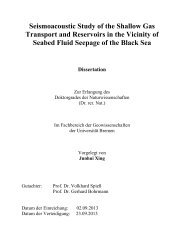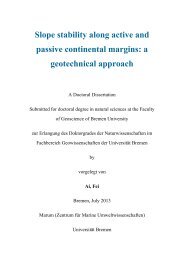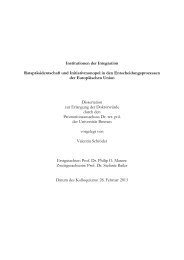aus dem MARUM und dem Fachbereich Geowissenschaften der ...
aus dem MARUM und dem Fachbereich Geowissenschaften der ...
aus dem MARUM und dem Fachbereich Geowissenschaften der ...
You also want an ePaper? Increase the reach of your titles
YUMPU automatically turns print PDFs into web optimized ePapers that Google loves.
MARIA S. MERIAN-Berichte, Cruise 20, Leg 4, Bridgetown – Freeport, 15.3.2012 – 7.4.2012<br />
astrophorid sponges (Fig. 6.28c) and several species of stalked crinoids. The low-relief ridged<br />
and almost flattened off-mo<strong>und</strong> seabed shows locally cemented crusts (Fig. 6.28d) which might<br />
be outwashed, weak ripple areas of calcareous ooze and sand but also boul<strong>der</strong> fields. The latter<br />
serve as substrate for purple octorals (Fig. 6.28e) and large antipatharian colonies, again each<br />
one housing a pair of bellotid fishes. Interestingly, in this region the CWC showed a distinct,<br />
though temporarily variable, depth zonation. During ROV dives GeoB 16373 ("Mount Gay")<br />
and 16374 "flourishing" coral gardens (Fig. 6.28c) have been observed on the visited mo<strong>und</strong><br />
summits in depths shallower than 610-620 m. In contrast, during ROV dive GeoB 16381 the<br />
summit of the visited mo<strong>und</strong> only reached up as high as 650 m and it was entirely covered by<br />
huge amounts of dead coral framework. This observation clearly points to a temporal<br />
development of the CWC distribution in this region.<br />
Also the two ROV dives higher up on the slope (GeoB 16387, 16388) over the flanks of an<br />
isolated mo<strong>und</strong> in 586-547 m depth shows no coral mo<strong>und</strong> but instead a displaced olistolith that<br />
is draped locally by coral framework. On ROV dive GeoB 16388 several graveyards with masses<br />
of sea urchin coronas and masses of bivalve shells were encountered at the base of the mo<strong>und</strong>ed<br />
structure (Fig. 6.28f). Among the collected shells, lucinid bivalves have been identified which<br />
may indicate seepage in this area. Other indications for seepage (of whatever origin) were noted<br />
on dive GeoB 16374 at 626 m water depth, when we spotted flurry water passing by.<br />
It is most likely the case that a two-fold history explains the presence of clustered and often<br />
E-W aligned mo<strong>und</strong>s: first the slope failure and mass transport of rock slabs from the platform<br />
perpendicular to the slope (E-W), second, the post-failure colonisation and mo<strong>und</strong> growth by<br />
corals. This also would explain the highly variable mo<strong>und</strong> morphology of individual mo<strong>und</strong>s<br />
which are not current controlled but primarily controlled in their shape by the random<br />
accumulation of displaced rock slabs.<br />
6.5.5 Great Bahama Bank Sediment Sampling<br />
(Claudia Wienberg, Dierk Hebbeln, Nina Joseph, Lelia Matos, Hector Reyes, Marco<br />
Taviani, Kl<strong>aus</strong> Dehning, Marco Klann, Maik Wilsenack)<br />
Three mo<strong>und</strong> structures were successfully sampled in the Great Bahama Bank region, all<br />
belonging to the deep mo<strong>und</strong> area between 700-600 m water depth observed during various<br />
ROV dives (GeoB 16366, 16373, 16374, 16381). The first southernmost sampling site of this<br />
area comprised a rather small mo<strong>und</strong> structure (situated slightly south of Mount Gay, see Fig.<br />
6.25). Two box cores collected from 660 m (GeoB 16367) and from 667 m (GeoB 16368) water<br />
depth revealed quite different recoveries. Whereas GeoB 16367 consisted of Enallopsammia<br />
rubble within a light grey muddy foraminifera-pteropod matrix, GeoB 16368 was made up by a<br />
pale brown foraminifera-pteropod ooze with very few coral fragments. Both cores contained<br />
scarce to no living fauna.<br />
Slightly to the north, we selected one larger mo<strong>und</strong> structure for intense sampling (Mount<br />
Gay, 79°21.25’W, 24°33.60’N; Fig. 6.25). This mo<strong>und</strong> was sampled with a series of box cores<br />
and gravity cores (see below) covering its base, lower and middle slopes, and its top. The mo<strong>und</strong><br />
base (GeoB 16375) and the lower slope (GeoB 16376) consisted of a pale brown muddy<br />
sediment, whereby only the box core from the mo<strong>und</strong> base contained a larger amount of coral<br />
rubble. No obvious living macrofauna was recognized. The mid-slope core (GeoB 16377) was<br />
washed out, however, some pale brown muddy sediment remained in the box. This was<br />
45

















